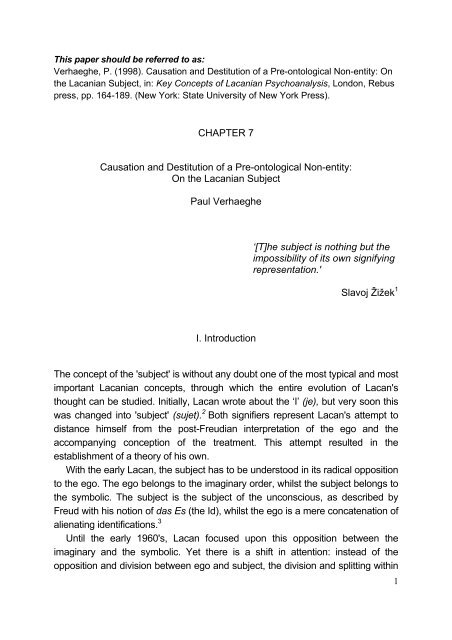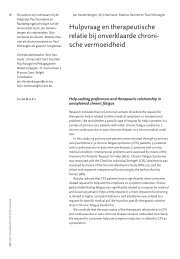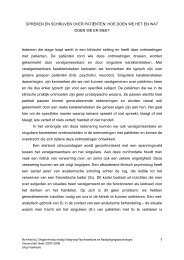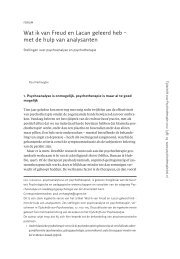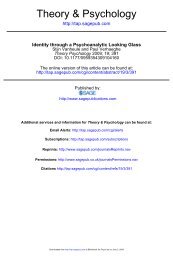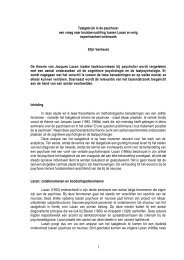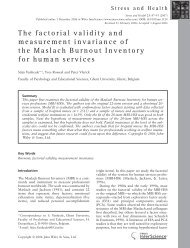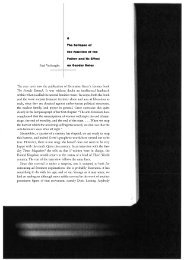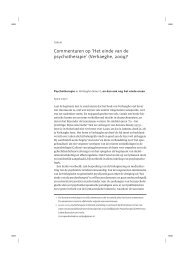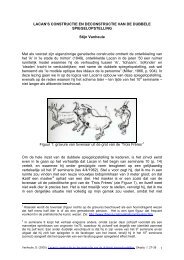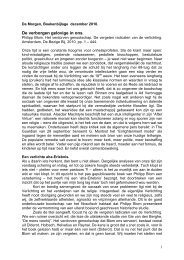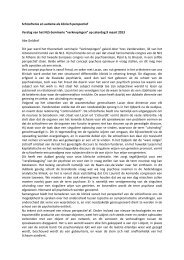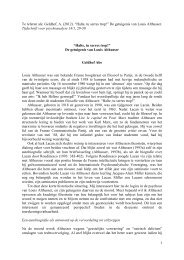Causation and Destitution of a Pre-ontological Non-entity
Causation and Destitution of a Pre-ontological Non-entity
Causation and Destitution of a Pre-ontological Non-entity
You also want an ePaper? Increase the reach of your titles
YUMPU automatically turns print PDFs into web optimized ePapers that Google loves.
This paper should be referred to as:Verhaeghe, P. (1998). <strong>Causation</strong> <strong>and</strong> <strong>Destitution</strong> <strong>of</strong> a <strong>Pre</strong>-<strong>ontological</strong> <strong>Non</strong>-<strong>entity</strong>: Onthe Lacanian Subject, in: Key Concepts <strong>of</strong> Lacanian Psychoanalysis, London, Rebuspress, pp. 164-189. (New York: State University <strong>of</strong> New York <strong>Pre</strong>ss).CHAPTER 7<strong>Causation</strong> <strong>and</strong> <strong>Destitution</strong> <strong>of</strong> a <strong>Pre</strong>-<strong>ontological</strong> <strong>Non</strong>-<strong>entity</strong>:On the Lacanian SubjectPaul Verhaeghe‘[T]he subject is nothing but theimpossibility <strong>of</strong> its own signifyingrepresentation.'Slavoj Žižek 1I. IntroductionThe concept <strong>of</strong> the 'subject' is without any doubt one <strong>of</strong> the most typical <strong>and</strong> mostimportant Lacanian concepts, through which the entire evolution <strong>of</strong> Lacan'sthought can be studied. Initially, Lacan wrote about the ‘I’ (je), but very soon thiswas changed into 'subject' (sujet). 2 Both signifiers represent Lacan's attempt todistance himself from the post-Freudian interpretation <strong>of</strong> the ego <strong>and</strong> theaccompanying conception <strong>of</strong> the treatment. This attempt resulted in theestablishment <strong>of</strong> a theory <strong>of</strong> his own.With the early Lacan, the subject has to be understood in its radical oppositionto the ego. The ego belongs to the imaginary order, whilst the subject belongs tothe symbolic. The subject is the subject <strong>of</strong> the unconscious, as described byFreud with his notion <strong>of</strong> das Es (the Id), whilst the ego is a mere concatenation <strong>of</strong>alienating identifications. 3Until the early 1960's, Lacan focused upon this opposition between theimaginary <strong>and</strong> the symbolic. Yet there is a shift in attention: instead <strong>of</strong> theopposition <strong>and</strong> division between ego <strong>and</strong> subject, the division <strong>and</strong> splitting within1
theorists.Following Freud, Lacan considered the drive as essentially partial, withoutthere being any global sexual drive comprising a closed reciprocity between twocomplementary genders with two complementary instincts. The insistent attempt<strong>of</strong> the drive to reinstall an original situation stresses the fact that this original stateis forever lost. Every drive pulsates around an original loss <strong>and</strong> thus around anirreversible lack, which puts object relations theory in a totally different light. 9At this point a very clear line from Freud can indeed be drawn, especially fromhis ideas on pleasure <strong>and</strong> unpleasure, <strong>and</strong> their importance within ontogeny. Inorder to acknowledge this line, we have to study some <strong>of</strong> the lesser known<strong>and</strong>/or more difficult Freudian works, namely the Project for a ScientificPsychology (1895), Beyond the Pleasure Principle (1920), the paper on Negation(1925) <strong>and</strong> his metapsychological writings in general. 10The gist <strong>of</strong> these ideas can be found in the Project. According to Freud,development starts with the loss <strong>of</strong> a primary experience <strong>of</strong> satisfaction <strong>and</strong> theattempt to regain the original homeostasis. The first reaction consists inhallucinating the lost satisfaction (which will return in the character <strong>of</strong> wishfulfilment typical <strong>of</strong> dreamlife), but this is not enough. The primitive organism hasto venture in the outside world in order to regain the lost satisfaction. From thispoint onwards, the relationship between what Freud calls the 'undifferentiatedvesicle' (undifferenziertes Bläschen) <strong>and</strong> the 'external world' (Außenwelt) isdeveloped. 11 The primary mental apparatus explores the external world by takingsamples from it. The two basic mechanisms involved are incorporation <strong>and</strong>expulsion, through which the external world is divided into a good <strong>and</strong> a bad part.What yields pleasure is kept inside the ego; what results in unpleasure is spatout. Later, it will become evident that these two mechanisms <strong>of</strong> incorporation <strong>and</strong>expulsion are the precursors <strong>of</strong> the Lacanian ones. For the time being, it is thisstarting-point which retains our attention.Freud assumed that there is an original state <strong>of</strong> primary satisfaction, which heconsidered to be a state <strong>of</strong> homeostasis. The inevitable loss <strong>of</strong> this state sets thedevelopment in motion <strong>and</strong> provides us with the basic characteristic <strong>of</strong> everydrive: the tendency to return to an original state. Thus, the entire development ismotivated by a central loss, around which the ego is constituted. WithFreud, <strong>and</strong> especially with the post-Freudians, the emphasis will be upon theinstallation <strong>of</strong> substitute satisfactions, ranging from neurotic symptoms <strong>and</strong>fantasies to sublimation. Yet these substitute satisfactions are never satisfactoryenough. The lack is irrevocable.Freud's key denomination for this lack is castration, which is his attempt at3
formulating the link between the original, pregenital loss <strong>and</strong> the oedipalelaboration there<strong>of</strong>. For several reasons, the Freudian castration theory itself willnever be fully satisfying. Freud's focus on the real, that is to say the biologicalbasis <strong>of</strong> castration, did not help him any further either, <strong>and</strong> inevitably brought himto the pessimistic conclusion <strong>of</strong> 1937, concerning the 'biological bedrock' as thelimit <strong>of</strong> psychoanalysis. 12 Freud's theory is quite unidimensional <strong>and</strong> Freudhimself remained remarkably obstinate in this respect. He refused to take otherlosses than the loss <strong>of</strong> a penis into account – with one exception, as becomesclear from his affirmation <strong>of</strong> Aristophanes' fable about the search for the originallylost counterpart. 13This one-sidedness was directed by his conviction regarding the universality<strong>of</strong> the pleasure principle, i.e. <strong>of</strong> the desire to restore the original homeostasis.Things became more complicated once he discovered that there is a 'beyond' tothe pleasure principle, in which yet another kind <strong>of</strong> drive is at work, also strivingto restore an original condition, albeit a totally different one. 14 The duality <strong>of</strong> lifeversus death drives opened up a dimension beyond the one-sidedness <strong>of</strong> neurosis,castration <strong>and</strong> desire.It is this dimension that is taken into account by Lacan. Indeed, Lacan'sstarting-point is also the very idea <strong>of</strong> lack <strong>and</strong> loss, but he will recognize a doubleloss <strong>and</strong> a double lack. Moreover, the interaction between those two losses willdetermine the constitution <strong>of</strong> the subject. The duality also corresponds to thedouble level <strong>of</strong> desire <strong>and</strong> jouissance <strong>and</strong> it will find its most elaborateformulation within Lacan's discourse theory, in which it will be expressed bymeans <strong>of</strong> the two disjunctions (impossibility <strong>and</strong> impotence) governing eachdiscourse. 15In Seminar XI, Lacan began his discussion <strong>of</strong> the causation <strong>of</strong> the subject withsomething that was already well-known to his audience: the drive, being alwaysa partial drive, revolves around a lack. However, at that point, Lacan surprisedhis audience by stating that there are two lacks. 16 The first one is the lack in thechain <strong>of</strong> signifiers, the interval between two signifiers. This is the typicallyhysterical – <strong>and</strong> thus Freudian – level in which desire can never be fullyexpressed, let alone satisfied. In Lacanian terms, this reads that the subject, confrontedwith the enigma <strong>of</strong> the desire <strong>of</strong> the Other, tries to verbalise this desire<strong>and</strong> thus constitutes itself by identifying with the signifiers in the field <strong>of</strong> the Other,without ever succeeding in filling the gap between subject <strong>and</strong> Other. Hence, thecontinuous movement from signifier to signifier, in which the subject alternatelyappears <strong>and</strong> disappears. The ensuing alienation is a continuous flywheelmovement around the lack in the chain <strong>of</strong> signifiers, resulting in what Lacan4
called l’avènement du sujet, the advent <strong>of</strong> the subject. 17So far, Lacan's theory is not really new. It could also be understood from aSartrean or an Althusserian point <strong>of</strong> view. The innovation begins when Lacansurprises his audience by stating that there is yet another lack, which he callsanterior <strong>and</strong> real in comparison to its counterpart. 18 Furthermore, the lack in thechain <strong>of</strong> signifiers is only a retake on this primal lack, the originality <strong>of</strong> whichresides in the fact that it has to be understood in the context <strong>of</strong> l’avènement duvivant (the advent <strong>of</strong> the living being). This entails the emergence <strong>of</strong> sexual reproductionin phylogeny, which is repeated with every ontogeny. 19 At this point,the level <strong>of</strong> Unbegriff (incomprehension), beyond the psychologicalcomprehensibility <strong>of</strong> the previous lack, is reached. 20 The anterior lack concernsthe price life has to pay for the acquisition <strong>of</strong> sexual reproduction. From themoment an organism becomes capable <strong>of</strong> reproducing itself in a sexual way, itloses its individual immortality <strong>and</strong> death becomes an unavoidable necessity. Atbirth, the individual loses something <strong>and</strong> this loss will be represented later on byall other substitute objects. 21Lacan tries to depict this primary loss with his myth <strong>of</strong> the lamella, the objectthat flies away at birth <strong>and</strong> that is nothing but pure life instinct. The lamella equalsthe libido, <strong>of</strong> which the four forms <strong>of</strong> the object a are the mere representatives.From this moment in Lacan's thought, there is an essential affinity between drive<strong>and</strong> death. 22 Sexual drive means death drive, as an inevitable consequence <strong>of</strong>the process <strong>of</strong> sexualization. 23 Here, Lacan endorses Freud's idea <strong>of</strong> a Triebmischung(a fusion <strong>of</strong> life <strong>and</strong> death drives) in The Ego <strong>and</strong> the Id, but he will gomuch further. 24 Indeed, Lacan will formulate a whole new theory <strong>of</strong> causality, inwhich he transcends the level <strong>of</strong> normal science that is only interested in laws,that is to say in regularity <strong>and</strong> predictability. Hence, the constitution <strong>of</strong> the subject is based on the interaction between life<strong>and</strong> death, between the two different lacks <strong>and</strong> their overlap. The Other is 'thefield <strong>of</strong> that living being in which the subject has to appear.' 26 The subjectencounters a lack in the discourse <strong>of</strong> the Other, in which the desire <strong>of</strong> the Other'crawls, slips, escapes, like the ferret,' producing an enigma to which the subjecthas to produce an answer. 27 It is at that point that the subject recurs to theanterior lack which entails its own disappearance. As an answer to the riddle <strong>of</strong>the desire <strong>of</strong> the Other, it presents itself <strong>and</strong> thus its disappearance: does theOther desire me, can s/he afford to lose me? This fantasy, in which one's owndeath is depicted as a form <strong>of</strong> testing the limits <strong>of</strong> the love <strong>of</strong> the Other, is fairlywell-known in adults <strong>and</strong> children alike: Veut-il me perdre?, Does he want to loseme?5
The crucial thing concerning these two lacks is that their interaction entailsneither reciprocity nor complementarity: 'It is a lack engendered from theprevious time that serves to reply to the lack raised by the following time.' 28 Theoverlap is situated in what Lacan calls 'the intersection between subject <strong>and</strong>Other,' <strong>and</strong> it is there that the second operation, which is termed 'separation,'takes place. The ever failing interaction between the two lacks also determinesthe non-existence <strong>of</strong> a perfect sexual relationship. This will be further elaboratedby Lacan in his theory <strong>of</strong> the four discourses, in which the two lacks receive theirfinal denomination: the lack on the upper level (the level <strong>of</strong> desire) concerns animpossibility (impossibilité), whereas the lack on the lower level (the level <strong>of</strong>jouissance) concerns impotence (impuissance). The four discourses are fourways <strong>of</strong> coping with these two lacks. 29The elaboration in Seminar XI <strong>of</strong> these two interacting operations, alienation<strong>and</strong> separation, will bring us to our second point, the onto-logical status <strong>of</strong> thesubject. As we will see, this status is a very particular one, as the main'characteristic <strong>of</strong> the subject <strong>of</strong> the unconscious is that <strong>of</strong> being . . . at anindeterminate place.' 30 Yet before going on to examine this, we should situateLacan's ideas on the causation <strong>of</strong> the subject into the more general framework <strong>of</strong>causality <strong>and</strong> the status <strong>of</strong> the unconscious as elaborated in the first part <strong>of</strong>Seminar XI. 31Indeed, Lacan's theory <strong>of</strong> the double lack may not be isolated from his ideason the status <strong>of</strong> the unconscious <strong>and</strong> the accompanying conception <strong>of</strong> causality.From a Lacanian point <strong>of</strong> view, the 'Gothic' interpretation <strong>of</strong> theunconscious is totally wrong. In this romantic conception, the unconscious isviewed as the basement <strong>of</strong> the psyche, in which all ancient dreads <strong>and</strong> desireslie buried until the unavoidable day <strong>of</strong> their resuscitation. Freud's theory,including concepts such as 'the return <strong>of</strong> the repressed,' 'repetition compulsion,'etc., would be nothing more than the scientific elaboration <strong>of</strong> this unavoidability.Obviously, such a conception implies a complete determinism, ins<strong>of</strong>ar as ahuman being can only become what s/he already was. This tallies with themechanistic-deterministic conviction <strong>of</strong> early twentieth century science, but itdoes not leave much room for therapeutic hope.Lacan not only distances himself from this substantiated interpretation <strong>of</strong> theunconscious, he even subverts it: the unconscious is <strong>of</strong> the order <strong>of</strong> the , the'non-realised,' the 'unborn,' 'limbo' (les limbes). 32 As a process, it is alwayssituated at the border; in itself, it is a void, an abyss: 'For what the unconsciousdoes is to show us the gap through which neurosis recreates a harmony with areal – a real that may well not be determined.' 33 This abyss is pre-<strong>ontological</strong>: not6
<strong>of</strong> the order <strong>of</strong> to be or not to be, but <strong>of</strong> the order <strong>of</strong> the not-realised. 34 And if thisunconscious becomes realised, it always happens in a bungled, failed way. Theunconscious formations are 'impediments' (achoppements), 'failures'(défaillances), whose most typical characteristic is their temporal scansion: theunconscious opens <strong>and</strong> closes at the same time. 35 It is important to underst<strong>and</strong>that this always failing realisation does not take place against a hidden (becauseunconscious) background <strong>of</strong> totality or unity. On the contrary, the background isnever there. Lacan summarises this subversion with a pun on the 'un' <strong>of</strong>unconscious: 'Let us say that the limit <strong>of</strong> the Unbewußte is the Unbegriff – not thenon-concept, but the concept <strong>of</strong> lack.' 36It is evident that this opens completely different perspectives on the subject <strong>of</strong>determinism. On the whole, Lacan is much more optimistic than Freud in thisrespect. 'It is always a question <strong>of</strong> the subject qua indeterminate,' <strong>and</strong> this haseffects on the goal <strong>and</strong> finality <strong>of</strong> the treatment. 37 But the innovation goes muchfurther, as it also implies a new view on the tricky subject <strong>of</strong> causality. Thenovelty resides in the way Lacan puts the lack at the centre <strong>of</strong> the – indeed –tw<strong>of</strong>old stage. The denominations are provided by Aristotle, but their content isnew: automaton (αủτoματov) versus tuchè (τuχη). 38 The automaton is the level that is the easiest to underst<strong>and</strong>. It concerns thenetwork or chain <strong>of</strong> signifiers, in which the 'pulsatile function <strong>of</strong> the unconscious'is at work. The barred subject ($) pops up <strong>and</strong> disappears under these signifiers– 'the signifier represents a subject for another signifier.' 39 In this, the subject isindeed determined, as Lacan had demonstrated time <strong>and</strong> again with his theoryon the unconscious as being structured like a language. 40 The automaticcharacter <strong>of</strong> this determinism was masterfully demonstrated in his Seminar on'The Purloined Letter,' showing how the chain <strong>of</strong> signifiers is indeed a chain. 41This is the level <strong>of</strong> the law, at which science aims, with its preponderant interestfor the causa efficiens (efficient cause), <strong>and</strong> it may convince one <strong>of</strong> theomnipresence <strong>of</strong> determinism. 42 It took Freud until 1920, in Beyond the PleasurePrinciple, to recognize the fallacy in this reasoning, <strong>and</strong> thus the hole in themechanistic universe. 43 The hole will prove to be a black one.This brings us to the second level. The unwinding <strong>of</strong> the associative chainsucceeds only to a certain point, something which Freud experienced time <strong>and</strong>again during his therapeutic work from the Studies on Hysteria onwards. 44 Theprocess <strong>of</strong> remembering succeeds only to a certain point where the chain stalls<strong>and</strong> shows an abyss, a gap. 45 This is what Freud termed the 'primal repressed,'<strong>and</strong> what he also called the Nabel (navel) <strong>of</strong> the dream <strong>and</strong> the Kern unseresWesens (the core <strong>of</strong> our being). 46 It is at this point that the real ex-sists, the real in7
the sense <strong>of</strong> what cannot be assimilated by the chain <strong>of</strong> signifiers. 47 Hence, thealways missed encounter, due to the lack <strong>of</strong> a signifier as meeting-point. Thisradical lack is conceptualised by Lacan with the idea <strong>of</strong> tuchè <strong>and</strong> it isunderstood in terms <strong>of</strong> absence, abyss <strong>and</strong> cut, where the law <strong>and</strong> regularity <strong>of</strong>the chain are failing. This is also the level <strong>of</strong> pure causality, where law <strong>and</strong>predictability fail. 'In short, there is cause only in something that doesn't work.' 48Hence, we find ourselves again dealing with two levels. On the one h<strong>and</strong>, thereis the chain <strong>of</strong> signifiers with the lack between them (Freud: the repressed). Thisis the level <strong>of</strong> the automaton, <strong>of</strong> the law <strong>and</strong> predictability, <strong>and</strong> thus <strong>of</strong> science.Underlying this chain, we find a more fundamental lack, concerning the realbeyond any signifier (Freud: the primal repressed). This is the level <strong>of</strong> the tuchè,<strong>of</strong> cause <strong>and</strong> unpredictability.With this theory, Lacan solves the classical question about the cause <strong>of</strong> thecause. The first cause lacks any determination whatsoever. 49 Theinteraction between the two levels consists in the never ending attempt <strong>of</strong> thechain <strong>of</strong> signifiers to produce an answer to the real. This attempt fails <strong>and</strong> resultsin the exact opposite: the more signifiers produced, the further one moves awayfrom this real. Therefore, in Seminar XX, Lacan defines the real as 'what doesnot stop not writing itself. ' 50What is this real all about? Lacan is quite clear on this point. The real beyondthe signifier, functioning as cause, is drive-ridden, <strong>and</strong> that is why Lacan took thedrive as his starting-point. With this aspect <strong>of</strong> the real, the meeting is always afailed one, because it contains no signifier. In the course <strong>of</strong> his teaching, Lacanenumerated the various manifestations <strong>of</strong> the real: the Other <strong>of</strong> the Other, thesexual relationship, Woman (La femme), all <strong>of</strong> them summarized in the notation<strong>of</strong> the barred Other. 51 In this respect, the subject is fundamentally undetermined,<strong>and</strong> that is why it has a possibility <strong>of</strong> choice, beyond the determination <strong>of</strong> theautomaton. This aspect <strong>of</strong> choice was already implicit in Freud's idea <strong>of</strong>Neurosenwahl (choice <strong>of</strong> neurosis) <strong>and</strong> it is made explicit with Lacan's idea <strong>of</strong> laposition du sujet: the subject has to take a position. 52 Which position? A positionvis-à-vis the lack <strong>of</strong> the Other, <strong>of</strong> the symbolic order; a position vis-à-vis thedesire <strong>and</strong> the jouissance <strong>of</strong> the Other. It is this element <strong>of</strong> choice that providesthe subject with a possibility <strong>of</strong> change, beyond the inescapable determination <strong>of</strong>the automaton. This finds an expression in Lacan's ideas on the future anterior:choices made now will determine the future <strong>of</strong> the subject, which therefore showsin itself a fundamental indeterminateness. 53 This provides us with the possibility<strong>of</strong> change, beyond the ever present Freudian determinism. In this respect,Lacan's elaboration <strong>of</strong> the goal <strong>and</strong> finality <strong>of</strong> psychoanalysis will be different, as8
we will show in the last part <strong>of</strong> this chapter.Thus, the 'un' <strong>of</strong> unconscious has to be taken seriously, just like the bar in thesubject ($): it denotes a pre-<strong>ontological</strong> dimension <strong>of</strong> non-realisation, <strong>of</strong> being unborn,within a perpetual process <strong>of</strong> opening <strong>and</strong> closing. We must now examinethis double process.III. The <strong>Pre</strong>-<strong>ontological</strong> Status: L'avènement du sujetIn the first part, we demonstrated how the subject is caused by the primaryexperience <strong>of</strong> a lack. The attempt at solving this lack by using signifiers entails aconfrontation with another lack, this time within the chain <strong>of</strong> signifiers. In thissecond part, we will concentrate on the two constitutive processes within thiscausation <strong>of</strong> the subject: alienation <strong>and</strong> separation. The first one is fullyelaborated by Lacan <strong>and</strong> can easily by traced back to Freud. The second oneconcerns Lacan's interpretation <strong>of</strong> the end <strong>and</strong> the finality <strong>of</strong> the analytictreatment. His theoretical development in these matters comprises an evershifting interpretation <strong>of</strong> this idea <strong>of</strong> separation.For Lacan, the advent <strong>of</strong> the subject takes place in a field <strong>of</strong> tension betweenthe subject-to-be <strong>and</strong> the field <strong>of</strong> the Other: 'The Other is the locus in which issituated the chain <strong>of</strong> the signifier – it is the field <strong>of</strong> that living being in which thesubject has to appear.' 54 In Freud's works, this field <strong>of</strong> tension is situatedbetween what must be regarded as a 'primary ego' <strong>and</strong> the outside world. 55 Thisprimary ego is in a state <strong>of</strong> tension due to the loss <strong>of</strong> the original state <strong>of</strong>satisfaction, which obliges it to try to restore this original state. This is <strong>of</strong> coursethe basic characteristic <strong>of</strong> every drive: the tendency to return to an originalsituation. Initially, the primary ego tries to satisfy itself by hallucinating the originalsatisfaction, but this proves to be inadequate. The next step brings the primaryego into interaction with the outside world, in order to find there what was lost.Freud's underst<strong>and</strong>ing <strong>of</strong> this interaction between the primitive organism <strong>and</strong>the outside world is very instructive if one wants to underst<strong>and</strong> the Lacanianpoint <strong>of</strong> view. We have already referred to Freud's ideas on incorporation <strong>and</strong>expulsion, the interactions between the primitive ego <strong>and</strong> the outside worldthrough which the external world is divided into a good <strong>and</strong> a bad part. Theseprocesses are fairly well-known in biology <strong>and</strong> ethology, <strong>and</strong> to some extent theycan even be recognised in infants. A baby explores the world with its mouth. Thefirst good external world, the mother's milk, is incorporated, <strong>and</strong> along that path a9
number <strong>of</strong> other things will follow. By contrast, the bad parts <strong>of</strong> the external worldare literally spat out. At a further developmental stage, these interactions willmake use <strong>of</strong> perceptual images <strong>of</strong> the outside world, rather than being carriedout literally. Traces <strong>of</strong> the interactions themselves can be recognised inthe language <strong>of</strong> love <strong>and</strong> hate: devouring love (the importance <strong>of</strong> a kiss is toknow when to stop – think <strong>of</strong> Hannibal Lecter), <strong>and</strong> 'you make me puke.' 56This primitive, pre-verbal level suffices to illustrate the fallacy <strong>of</strong> the idea <strong>of</strong>two interacting agencies. From a naive point <strong>of</strong> view, one could consider thisprocess as the interaction <strong>of</strong> the organism with the world, the 'inside' with the'outside.' Yet closer examination reveals an unexpected complexity, whichdestroys the idea <strong>of</strong> separate entities. The 'inside' is the result <strong>of</strong> an incorporation<strong>of</strong> the pleasurable parts <strong>of</strong> the outside, <strong>and</strong> the 'outside' is the result <strong>of</strong> anexpulsion <strong>of</strong> what was considered unpleasurable at the inside. In addition, thereal outside is what is unknown in terms <strong>of</strong> pleasure <strong>and</strong> unpleasure, <strong>and</strong> so itsimply does not exist for the organism. Thus, the inside is a pleasurable outside,the outside is an unpleasurable inside, <strong>and</strong> the outside as such is notrecognised. This is the reason why Lacan refuses any form <strong>of</strong> 'two bodypsychology,' <strong>and</strong> why he introduces a completely new topology inpsychoanalysis, whose basic characteristic is the absence <strong>of</strong> differencesbetween outside <strong>and</strong> inside (see, for example, the Moebius strip <strong>and</strong> the Kleinbottle). 57Once the pre-verbal perceptual images are superseded by language, weleave biology <strong>and</strong> enter the truly human realm. Already at the time <strong>of</strong> the Projectfor a Scientific Psychology, Freud paid full attention to words, because language,that is to say the association between a word <strong>and</strong> a perceptual image, explainsthe typically human condition <strong>of</strong> consciousness, <strong>and</strong> thus also the fact thatsomething can become or remain unconscious. In this human realm, interactionsdo not take place between 'organism' <strong>and</strong> Umwelt, but between child <strong>and</strong> parent.Lacan will stress the language aspect in this interaction by using thedenominations <strong>of</strong> subject <strong>and</strong> Other. The latter comprises the m(Other)tonguethat will give rise to a second birth, turning the infant into a divided subject. InFreudian terms, the interaction on the verbal level involves different processesfrom those on the pre-verbal level. Instead <strong>of</strong> incorporating a piece <strong>of</strong> theUmwelt, the ego now identifies with the pleasure-procuring signifiers <strong>of</strong> the Other;instead <strong>of</strong> spitting out the bad parts <strong>of</strong> the outside world, the subject repressesthese parts. Language acquisition divides the human universe into twoessentially interwoven parts: 'pleasure – identification – ego – signifier – consciousness'versus 'unpleasure – repression – not-ego – without signifier –10
unconscious.' This Freudian metapsychology is usually understood from a developmental point<strong>of</strong> view. Moreover, the pleasure principle involved is a simple one, for it is basedon a singular lack. With Lacan, the accent will be put on a structural point <strong>of</strong> view,that is to say on a structure beyond development. Hence, the repercussions onthe <strong>ontological</strong> level. Moreover, as we have already pointed out, for Lacan thereare two levels, each characterised by a certain lack <strong>and</strong> a certain pleasure. Theimplications <strong>of</strong> this have a particular bearing upon on the goals <strong>of</strong> psychoanalytictreatment.The basic Lacanian mechanism is easy to describe: the subject-to-beidentifies with the pleasure-procuring signifiers in the field <strong>of</strong> the (m)Other <strong>and</strong>represses the unpleasurable ones. Easy as this may seem, it has a number <strong>of</strong>far-reaching consequences. Firstly, it confronts us with the astonishing fact thatthe very kernel <strong>of</strong> our personality is an empty space: peeling <strong>of</strong>f layer after layer<strong>of</strong> identification in search <strong>of</strong> the substantial kernel <strong>of</strong> one's personality, one endsup with a void, with the original lack. In Seminar I, Lacan compares the ego to anonion: 'The ego is constructed like an onion, one could peel it, <strong>and</strong> discover thesuccessive identifications which have constituted it. 58 Secondly, instead <strong>of</strong> havingan original id<strong>entity</strong>, a human being merely consists <strong>of</strong> identifications with parts <strong>of</strong>the other. This is the raw meaning <strong>of</strong> those classical Lacanian formulae, 'Man'sdesire is the desire <strong>of</strong> the other,' 'The unconscious is the discourse <strong>of</strong> the Other,'echoing T.S. Eliot's 'We are the hollow men/We are the stuffed men/Leaningtogether/Headpiece filled with straw. Alas!'. 59 No wonder, then, that Lacan coinedthe basic mechanism in the advent <strong>of</strong> the subject 'alienation.' 60It has already become clear that this process takes place between subject<strong>and</strong> Other. However, this does not imply a naive two body psychology, as wehave seen. This, incidentally, is the reason Lacan stopped using the concept <strong>of</strong>'intersubjectivity,' as it reminded him far too much <strong>of</strong> this two body model. 61Implicit in Lacan's reasoning, there are two levels in alienation, corresponding tothe two lacks mentioned above. The first level concerns the mythical point <strong>of</strong>origin – mythical because <strong>of</strong> the very idea <strong>of</strong> origin – in which l’être (being) assuch has to make its appearance in the field <strong>of</strong> the Other, <strong>of</strong> language. Thiscoincides with what Freud, in his essay on Moses, calls 'hominization'(Menschwerdung), the process <strong>of</strong> becoming a human being. 62 11
Even at this primary level, the effects are quite dramatic: when being makes itsappearance on the level <strong>of</strong> language, it must disappear under that language, itloses the reality <strong>of</strong> its being. For Lacan, this is a matter <strong>of</strong> choice, albeit a veryspecial choice, for whatever decision is made, one element is lost forever. Hecompares this choice to the classical 'Your money or your life!'. Whatever youchoose, you will lose your money anyway. The element lost in the process <strong>of</strong>becoming a human being is being itself, the pure being, the real, the thing withouta name, leaving us with a basic lack as a condition for our becoming, whichLacan calls manque à être (want-to-be, or lack <strong>of</strong> being). 63 Thus, right from thestart, the subject is divided between the necessary loss <strong>of</strong> its being on the oneh<strong>and</strong> <strong>and</strong> the ever alienating meaning in the Other on the other h<strong>and</strong>. Thesubject chooses the (m)Other in order to regain the lost paradise <strong>of</strong> the primaryexperience <strong>of</strong> satisfaction, <strong>and</strong> the net result will be an ever more cleardelineation <strong>of</strong> this loss. 64The second level concerns the chain <strong>of</strong> signifiers, the automaton, in which thesubject continuously appears <strong>and</strong> disappears in an ever repeated division by thesignifiers: '[A] signifier is that which represents the subject for another signifier.' 65Here again, the subject can 'choose' its signifiers in the field <strong>of</strong> the Other, but thischoice reminds one <strong>of</strong> that mentioned by Ferdin<strong>and</strong> de Saussure in his Course inGeneral Linguistics. There he demonstrated the arbitrary relationship betweensignifier <strong>and</strong> signified, <strong>and</strong> the consequences <strong>of</strong> this for the freedom <strong>of</strong> choice.Basically, you can pick your own signifiers, but <strong>of</strong> course the choice has alreadybeen made for you <strong>and</strong> before you, hence his expression: la carte forcée de lalangue, meaning that language is a 'set-up.' 66 12
When comparing this Lacanian operation to the Freudian ones, it becomesobvious that alienation comprises both identification <strong>and</strong> repression. This can bedemonstrated with Lacan's definition <strong>of</strong> metaphor, as 'the substitution <strong>of</strong> signifierfor signifier.' 67 The subject 'chooses' a signifier, which appears on top <strong>of</strong> anothersignifier. The latter becomes repressed, whereas the former entails a newidentification for the ego <strong>and</strong> the subject remains divided between the two <strong>of</strong>them. In Freudian terms, the ego is nothing but a concatenation <strong>of</strong> identifications,as a result <strong>of</strong> the successive object losses. In this line <strong>of</strong> reasoning, the first level<strong>of</strong> alienation corresponds to the primal repression (Urverdrängung) <strong>and</strong> theprimary identification. Indeed, the primal repression constitutes the kernel <strong>of</strong> theunconscious as something that is forever lost <strong>and</strong> can never be verbalised,namely the real <strong>of</strong> the drive. 68 The primary identification is for Freud always the i-dentification with the father, <strong>and</strong> this identification provides the platform fromwhich development, in the form <strong>of</strong> the Oedipus complex, takes <strong>of</strong>f. 69 For Lacan,this implies the installation <strong>of</strong> the S 1 , the master signifier.The second level <strong>of</strong> alienation corresponds to the Freudian eigentlicheVerdrängung (repression proper) or Nachdrängen (after-pressure), which can beinterpreted as a secondary repression <strong>and</strong> which takes place completely withinthe chain <strong>of</strong> signifiers. 70 Unconscious processes or formations, which are madeup from signifying material, take place at the border <strong>of</strong> the unconscious, as isdemonstrated by a slip <strong>of</strong> the tongue, the forgetting <strong>of</strong> a proper name, etc. TheSignorelli example in Freud's The Psychopathology <strong>of</strong> Everyday Lifedemonstrates both levels in a perfect way. The lost signifiers, due to thesecondary repression, can be retrieved by means <strong>of</strong> free association, but thebasic lack cannot be verbalised <strong>and</strong> is merely hinted at by Freud in his mention<strong>of</strong> 'death <strong>and</strong> sexuality' <strong>and</strong> 'repressed thoughts' at the bottom <strong>of</strong> his schema. 7113
In Lacan's theory <strong>of</strong> the four discourses, both levels will be expressed by themaster's discourse. The subject is forever barred from the lost object a <strong>and</strong> isthus impotent in matters <strong>of</strong> <strong>and</strong> protected against jouissance. It finds its firstalienating id<strong>entity</strong> with the S 1 , the Oedipal master signifier <strong>of</strong> the father. Fromthen onwards, the subject will appear <strong>and</strong> disappear under the never-endingchain <strong>of</strong> signifiers, S 2 , in an attempt to bridge the gap <strong>and</strong> reach for satisfaction.The result <strong>of</strong> this impossible attempt is an ever increasing production <strong>of</strong> the lostobject a. 72The master discourseThe important thing about the divided subject is that it has no essence, no<strong>ontological</strong> substance, but, on the contrary, comes down to a pre-<strong>ontological</strong>,indeterminate non-being which can only give rise to an id<strong>entity</strong>, an ego, inretrospect. Difficult as this may seem, it is rather easy to grasp. Just think <strong>of</strong> whatwe will call 'the cocktail experience.' You are invited for a drink with a group <strong>of</strong>people you do not know. You have to introduce yourself, <strong>and</strong> so you have toproduce signifiers. This production <strong>of</strong> signifiers will never be satisfactory.Furthermore, the more signifiers produced, the more contradictions, gaps <strong>and</strong>difficulties will become clear. Therefore, the 'Experienced Cocktail Consumer’,will stick to the proverbial 'That's me!' <strong>and</strong> produce a stock introduction.From a Lacanian point <strong>of</strong> view, it would be wrong to assume that the difficultylies in finding the correct signifiers to present oneself. On the contrary, one isproduced by the uttered signifiers, which are coming from the field <strong>of</strong> the Other,albeit in a divided way. It would also be a mistake to assume that the subject isidentical to the produced signifier(s). The identification with a number <strong>of</strong>signifiers, coming from the Other, presents us with the ego. The subject, on thecontrary, is never realised as such; it joins the pre-<strong>ontological</strong> status <strong>of</strong> theunconscious, the unborn, non-realised etc. In this sense, the Lacanian 14
subject is exactly the opposite <strong>of</strong> the Cartesian one. In the formula 'I am thinking,therefore I exist' Descartes concludes from his thinking that he has a being,whereas for Lacan, each time (conscious) thinking arises its being disappearsunder the signifier. 73This explains two basic characteristics <strong>of</strong> the Lacanian subject: it is always atan indeterminate place <strong>and</strong> it is essentially divided:Alienation consists in this vel, which - if you do not object to the wordcondemned, I will use it - condemns the subject to appearing only inthat division which, it seems to me, I have just articulated sufficientlyby saying that, if it appears on one side as meaning, produced bythe signifier, it appears on the other as aphanisis. 74Again, Lacan distances himself from any idea <strong>of</strong> substantiality. The subject is notan unconscious intention that will interrupt the normal conscious discourse. Theinterruption or division does not take place between a real or authentic part <strong>and</strong> afalse, external one, but the split defines the subject as such. The subject is splitfrom its real being <strong>and</strong> forever tossed between eventually contradicting signifierscoming from the Other.This rather pessimistic view confronts us with the issue <strong>of</strong> therapeutic <strong>and</strong>psychoanalytic possibilities. Paradoxical as this may seem, Lacan's point <strong>of</strong> viewis more optimistic than the Freudian one. Freud's theory is by <strong>and</strong> largedeterministic, whereas Lacan leaves an element <strong>of</strong> choice, albeit a 'forced'choice. It is this element that brings us to the second operation, separation, <strong>and</strong>to the theme <strong>of</strong> our final investigation: the goal <strong>of</strong> psychoanalytic treatment.IV. The Goal <strong>of</strong> Psychoanalysis: La destitution subjectiveThe vicissitudes <strong>of</strong> the subject depend largely on the direction <strong>of</strong> the treatment<strong>and</strong> its goal. It is precisely at this point that Lacan will change <strong>and</strong> revise histheory, with accompanying changes concerning the subject. Generally speaking,the Lacan before Seminar XI can be considered as the Lacan <strong>of</strong> the symbolic<strong>and</strong> the imaginary, while from Seminar XI onwards, these categories willbe completed <strong>and</strong> changed by the introduction <strong>of</strong> the real. The effect there<strong>of</strong> isthat the whole previous conceptualisation has to be reconsidered, in a typicallypsychoanalytical process <strong>of</strong> 'deferred action' (Nachträglichkeit). 7515
Before Seminar XI, the idea <strong>of</strong> alienation already occupied a very prominentplace in Lacan's thinking. His paper on The Mirror Stage demonstrates thatalienation is a necessary operation, which cannot be restricted only to theprocess <strong>of</strong> socialisation, for it is precisely what determines this process. 76 Thefurther elaboration <strong>of</strong> the mirror stage introduces the alienation into the structuralrelation between the imaginary <strong>and</strong> the symbolic. 77 The primary imaginaryalienation is determined by the secondary symbolic one, which relies on theOther. The subject wants to be loved/desired by the Other <strong>and</strong> models/alienateshim or herself on the image <strong>of</strong> what s/he thinks is desirable for this Other. Here,the goal <strong>of</strong> psychoanalysis is to recognise this Other <strong>and</strong> its influence.Separation is understood as a major operation, installed through the paternalmetaphor. 78 It is the function <strong>of</strong> the father/Other to separate the child <strong>and</strong> the first(m)Other. The real is never mentioned.In Seminar XI, all this is radically changed. Alienation <strong>and</strong> separation arelinked to the tw<strong>of</strong>old lack <strong>and</strong> they install the subject in a never ending pulsatingprocess <strong>of</strong> appearing <strong>and</strong> disappearing. Alienation takes the subject away fromits being, in the direction <strong>of</strong> the Other. Separation is the opposite process,inasmuch as it redirects the subject towards its being, thus opening a possibility<strong>of</strong> escape from the all-determining alienation, <strong>and</strong> even a possibility <strong>of</strong> choice,albeit a precarious one. The two processes are circular <strong>and</strong> dissymmetrical. Thecause <strong>of</strong> this continuous movement is the tw<strong>of</strong>old lack. The process <strong>of</strong> alienationconducts the subject towards the signifying chain <strong>of</strong> the Other. Inevitably, it willstumble upon the lack <strong>of</strong> the Other: 'He is saying this to me, but what does hewant?'. 79 Thus confronted with the nameless desire <strong>of</strong> the Other, the subject willproduce a very typical answer: 'Does the Other desire me?,' 'Am I the one whocan fulfil his desire?'. This implies that the subject answers the lack <strong>of</strong> the Otherby presenting his or her own disappearance: 'Can the Other afford to lose me'?'.The lack <strong>of</strong> the Other, within the signifying chain, is answered by a presentation<strong>of</strong> the lack at the anterior level, i.e. death as a real loss. Hence, the nonreciprocity<strong>and</strong> dissymmetry, by which the process topples over into thedirection <strong>of</strong> alienation again. This eliminates the possibility <strong>of</strong> a perfect sexualrelationship.With separation, the effect is the installation <strong>of</strong> a void between subject <strong>and</strong>Other, in which the object a makes its appearance. This void permits the subject<strong>and</strong> the Other to fall apart momentarily, to separate. Just think <strong>of</strong> the well-knownmetaphor <strong>of</strong> le bal masqué. When the couple finally meets <strong>and</strong> the partnersremove their mask, they discover their mistake: 'They met in Paris, at the Operaball. When they removed their masks, sheer terror! It wasn't him, her neither by16
the way.' 80 This negativity implies an escape from the all-embracing determinism<strong>of</strong> the Other <strong>and</strong> opens a limited possibility <strong>of</strong> choice. Within Seminar XI, this ishardly elaborated. Lacan plays both on the etymological <strong>and</strong> the homonymicalaspect <strong>of</strong> separation: se parere, to engender oneself <strong>and</strong> se parer, to defendoneself, to dress oneself. 81 He demonstrates the necessity <strong>of</strong> this process bydiscussing clinical instances in which it is lacking. This is what Lacan calls the'holophrase,' exemplified by a peculiar relationship between certain mothers <strong>and</strong>their children within which there is no gap whatsoever between the signifiers <strong>of</strong>the (m)Other, thus installing a complete alienation without any possibility <strong>of</strong>escape. 82 The child is the real obturation <strong>of</strong> the lack <strong>of</strong> the (m)Other. 83 But for the'real' elaboration <strong>of</strong> this idea <strong>of</strong> separation, we have to turn to Lacan's later work,focusing on the end <strong>of</strong> the analytic treatment.Before doing that, it is necessary to stress the shift that has occurred sinceLacan's first theory. In the later stages <strong>of</strong> his conceptualisation, Lacan states thatthe Other <strong>of</strong> the Other does not exist; it is lacking, separation being theinteraction between the lack <strong>of</strong> the Other <strong>and</strong> the lack <strong>of</strong> the subject. Thedistance between this idea <strong>of</strong> separation, <strong>and</strong> the idea <strong>of</strong> separation expressedby the paternal metaphor, is immense, <strong>and</strong> entails a crucial shift in the direction<strong>of</strong> the treatment.Lacan abhorred the idea <strong>of</strong> an analysis ending in an identification with theanalyst, which would imply just another alienation. For Lacan, the analyst'sdesire ought to aim at the exact opposite, namely absolute difference. 84 Thisbrings us back to ontology <strong>and</strong> ethics. From the point <strong>of</strong> view <strong>of</strong> alienation, thesubject has no substance whatsoever; it is a mere <strong>and</strong>, moreover, an ever fadingeffect <strong>of</strong> the symbolic order, the Other. At this point, Lacanian theory belongs toconstructionism <strong>and</strong> determinism. Ideas <strong>of</strong> individuation, self-realisation, <strong>and</strong>subjective autonomy do not belong to this line <strong>of</strong> thought. They never will,yet the accent shifts once the real is introduced. Through separation, the subjectreceives an element <strong>of</strong> choice. Further elaborations continue to stress the innerdifficulty <strong>of</strong> this idea. The pinnacle <strong>of</strong> these is to be found in Lacan's elaboration<strong>of</strong> the 'traversing <strong>of</strong> fantasy' <strong>and</strong> the 'subjective destitution,' which replace theoriginal idea <strong>of</strong> separation. 85 Ultimately, the choice in all this is an impossible one,ins<strong>of</strong>ar as the choice has already been made, taking the shape <strong>of</strong> a peculiar form<strong>of</strong> identification. 86The first developments <strong>of</strong> this idea can be found in Seminar XI. Instead <strong>of</strong> theabhorred identification with the analyst at the end <strong>of</strong> analysis, Lacan suggeststhe existence <strong>of</strong> another form <strong>of</strong> identification, inaugurated by the process <strong>of</strong>separation, <strong>and</strong> thus by the object a: 'Through the function <strong>of</strong> the object a, the17
subject separates himself <strong>of</strong>f, ceases to be linked to the vacillation <strong>of</strong> being, inthe sense that it forms the essence <strong>of</strong> alienation.’ 87 This idea is not developedany further in this seminar <strong>and</strong> can hardly be understood here. Separation doesnot take place through the intervention <strong>of</strong> the Other <strong>and</strong> the symbolic; on thecontrary, it takes place through the object a <strong>and</strong> the real. Indeed, the Other <strong>of</strong> theOther does not exist, the Other is inconsistent. The discovery <strong>of</strong> its inconsistencyis the consequence <strong>of</strong> analysis <strong>and</strong> results in a mirror effect. If the Other isinconsistent, then the same goes for the subject, <strong>and</strong> both <strong>of</strong> them tumble downfrom their positions. This is what Lacan calls 'traversing the fantasy.' Applied toLacan's formula <strong>of</strong> the fantasy, , this traversing means that the subjectcrosses the lozenge <strong>and</strong> identifies with the lost object, i.e. with the cause <strong>of</strong> itsown advent: . In this way, the subject comes to subjective destitution: itassumes the non-existence <strong>of</strong> the Other <strong>and</strong> the non-existence <strong>of</strong> itself as asubject. With this, we have reached both the end <strong>of</strong> Lacan's theory <strong>and</strong> <strong>of</strong> histheory <strong>of</strong> the end <strong>of</strong> analysis. His final conceptualisations can be understood asan elaboration <strong>of</strong> the idea <strong>of</strong> separation, albeit from the point <strong>of</strong> view <strong>of</strong> theanalytical goal.What is the goal <strong>of</strong> analysis? At first sight, the answer is strange: a successfulanalysis brings the subject to the point where s/he can identify him or herself withthe symptom. This identification is a special one, because it concerns anidentification with the real <strong>of</strong> the symptom, <strong>and</strong> thus concerns an identification onthe level <strong>of</strong> being. 88 This is exactly the counterpart <strong>of</strong> what the analys<strong>and</strong>experienced before, namely the identification/alienation with the Other <strong>and</strong> theaccompanying belief in this Other, <strong>and</strong> thus in its existence. 89 The analyticexperience makes clear that this Other does not exist, <strong>and</strong> hence that the subjectdoes not exist either. This is 'subjective destitution' as the most radical form <strong>of</strong>separation. The analys<strong>and</strong> not only has to separate him or herself from theOther, s/he even has to discover the non-existence <strong>of</strong> the Other. The inevitableconsequence is that the subject, as a response to the lack <strong>of</strong> this Other, does notexist either. This paves the way to the real being <strong>of</strong> the subject, son être du sujet.From that point onwards, the subject cannot be considered a mere 'answerto/from the Other' (réponse de l'Autre) anymore; on the contrary, the subject isnow an 'answer to/from the real' (réponse du réel). Thus, the idea <strong>of</strong> se parere, toengender oneself, as it was announced in Seminar XI, is realised after all.This brings us to another important Lacanian dimension, that <strong>of</strong> creation.Indeed, in our opinion, the 'identification with the real <strong>of</strong> the symptom' has to beunderstood via the idea <strong>of</strong> creation. The gist <strong>of</strong> it can be recognised in Lacan'searlier ideas on sublimation <strong>and</strong> creatio ex nihilo in his Seminar VII on The Ethics18
<strong>of</strong> Psychoanalysis. The subject can 'choose' to elevate nothing into something<strong>and</strong> to enjoy this: 'The object is elevated to the dignity <strong>of</strong> the Thing.' 91 Applied tothe end <strong>of</strong> analysis, this means that the subject has created its own symptom inthe real <strong>and</strong> proceeds by identifying with it. In this way, the symptom takes theplace <strong>of</strong> what is forever lacking. Finally, it takes the place <strong>of</strong> the lacking sexualrapport <strong>and</strong> furnishes a self-made answer to it, instead <strong>of</strong> the previous, Othermadeones. Lacan accentuates this shift by introducing a neologism. The subjecthas to become a sinthome, a combination <strong>of</strong> symptôme (symptom) <strong>and</strong> sainthomme (holy man): 'On the level <strong>of</strong> the sinthome . . . there is relationship. Thereis only relationship where there is sinthome.' 92 This delineates a before <strong>and</strong> anafterwards. <strong>Pre</strong>viously, there was a belief in the symptom, which yielded asymbolic suppletion for the lack <strong>of</strong> the Other <strong>and</strong> which at once located thejouissance within the Other. At the end <strong>of</strong> analysis, the identification with thesinthome is a real suppletion, providing the subject not only with consistency, butalso with jouissance.The paradox is that the entailing 'rapport' inaugurates absolute difference.Notes19
1. S. Žižek, The Sublime Object <strong>of</strong> Ideology, London-New York NY, Verso, 1989, p.208.2. See: J. Lacan, The Mirror Stage as Formative <strong>of</strong> the Function <strong>of</strong> the I as Revealed inPsychoanalytic Experience (1949), Ecrits: A Selection (trans. A. Sheridan), London,Tavistock, 1977, pp. 1-7; 1. Lacan, The Function <strong>and</strong> Field <strong>of</strong> Speech <strong>and</strong> Language inPsychoanalysis (1953), Ecrits: A Selection, o.c., pp. 30-113.3. See: S. Freud, The Ego <strong>and</strong> the Id (1923b), St<strong>and</strong>ard Edition, XIX, pp. 1-66; J.Lacan, The Freudian Thing, or the Meaning <strong>of</strong> the Return to Freud in Psychoanalysis(1955), Ecrits: A Selection, o.c.., pp. 114-145 <strong>and</strong> p. 128 in particular.4. See: J. Lacan, Le Séminaire V, Les formations de l'inconscient (1957-58), unpublished.5. See: J. Lacan, The Four Fundamental Concepts <strong>of</strong> Psychoanalysis (1964) (trans. A.Sheridan), Edited by J.-A. Miller, London, The Hogarth <strong>Pre</strong>ss <strong>and</strong> the Institute <strong>of</strong>Psycho-Analysis, 1977.6. Ibid., pp. 203-215.7. Due to the recent boom in Lacanian publications, it is impossible to include acomplete bibliography <strong>of</strong> secondary sources on this subject. These are the two mostinteresting studies, in my opinion: B. Fink, The Lacanian Subject: Between Language<strong>and</strong> Jouissance, Princeton NJ, Princeton University <strong>Pre</strong>ss, 1995; D. Nobus, ChoosingSexuality: A Lacanian Inquiry into the Laws <strong>of</strong> Sexual Diversity. Albany NY. StateUniversity <strong>of</strong> New York <strong>Pre</strong>ss (forthcoming).8. See: J. Lacan, The Four Fundamental Concepts <strong>of</strong> Psychoanalysis, o.c., p. 203.9. This had already become clear from Lacan's fourth seminar, La relation d'objet(Object-relation), in which he had developed a theory <strong>of</strong> the lack <strong>of</strong> object. See: J.Lacan, Le Séminaire, Livre IV, La relation d'objet (1956-57), texte établi par J.-A. Miller,Paris, du Seuil, 1994, pp. 9-92.10. See: S. Freud, Project for a Scientific Psychology (1950c [1895]), St<strong>and</strong>ardEdition, I, pp. 295-343 & pp. 347-387; S. Freud, Beyond the Pleasure Principle (1920g),St<strong>and</strong>ard Edition, XVIII, pp. 7-64; S. Freud, Negation (1925h), St<strong>and</strong>ard Edition, XIX, pp.235-239.11. S. Freud, Beyond the Pleasure Principle, o.c., pp. 26-28.12. S. Freud, Analysis Terminable <strong>and</strong> Interminable (1937c), St<strong>and</strong>ard Edition, XXIII, pp.209-253 <strong>and</strong> p. 252 in particular.13. See: S. Freud, Analysis <strong>of</strong> a Phobia in a Five-Year-Old Boy (1909b). St<strong>and</strong>ardEdition, X, p. 8, note 2; S. Freud, Beyond the Pleasure Principle, o.c., p. 57; Plato, TheSymposium (trans. W. Hamilton), Harmondsworth, Penguin, 1990, 189d-193e(Aristophanes' fable).14. S. Freud, Beyond the Pleasure Principle, o.c. pp. 7-64.15. See: J. Lacan, Le Séminaire, Livre XVII, L 'envers de la psychanalyse (l969-70),texte établi par J.-A. Miller, Paris, du Seuil, 1991.16. Of course, this idea was not completely new. In Seminar IV, Lacan had alreadydescribed two periods in the relationship between a mother <strong>and</strong> her child: a first one,characterised by a 'primitive identification' (l'identification freudienne primitive) in which20
the child fills the lack <strong>of</strong> the mother , <strong>and</strong> a second one, in which the child <strong>of</strong>fers its ownlack, which will form the basis for every later infatuation. See: J. Lacan, Le Séminaire,Livre IV, La relation d'objet, o.c., pp. 174-178; J. Lacan, The Four FundamentalConcepts <strong>of</strong> Psychoanalysis ,o.c., pp. 204-205.17. J. Lacan, The Four Fundamental Concepts <strong>of</strong> Psychoanalysis, o.c., p. 205.18. Ibid., p. 205.19. Ibid., p. 205.20. Ibid., p. 26.21. Ibid., p. 198.22. Ibid., pp. 197-199.23. Due to the nature <strong>of</strong> science, this truth cannot be expressed by it. Therefore, onehas to turn to art <strong>and</strong> jokes. In the realm <strong>of</strong> art, we refer the reader to Bataille's Erotism:Death <strong>and</strong> Sensuality. As far as the jokes are concerned, the following selection mightsuffice: i/Patient: 'Doctor, if I quit drinking alcohol, restrict myself to vegetarian food <strong>and</strong>leave women for what they are, will I live longer?'; Doctor: 'I don't know whether you willlive longer, but I am pretty sure about one thing: you will have the impression that ittakes much longer.' ii/A gerontologist wants to answer the question as to why somepeople live much longer than others do. He interviews a number <strong>of</strong> people in a home forthe elderly. A seventy-year-old assures him that he owes his health to macrobiotic food,an octogenerian adds physical exercise, <strong>and</strong> a ninety-year-old declares never havingtouched a woman. At that point, our gerontologist sees what he considers to be hisperfect object <strong>of</strong> study: a man who must be at least a hundred. He asks the manwhether he was also particular about his food. Man: 'Indeed I was, only the best wasgood enough - no margarine for me, cream <strong>and</strong> butter, that's the thing!'; Gerontologist:'And what about your drinking habits? Did you restrict yourself on that point?'; Man: 'Ofcourse, I only consume the truly good wines – at least a gr<strong>and</strong> cru – <strong>and</strong> my daily bottle<strong>of</strong> whisky has to be a single malted one, I don't like the blended stuff, that's purepoison.'; Gerontologist: 'And women, what about women?'; Man: 'Oh, don't ask meabout women, I used to do it at least twice a day, but these days I don't get a hard-onthat easily anymore.'; Gerontologist: 'But for God's sake, how did you manage to get thatold?'; Man: 'Old, old! Let's not exaggerate, my dear chap, twenty-seven is not that old!'See: G. Bataille, Erotism: Death <strong>and</strong> Sensuality (1957) (trans. M. Dalwood), SanFrancisco CA, City Lights Books, 1986.24. See: S. Freud, The Ego <strong>and</strong> the Id (1923b), St<strong>and</strong>ard Edition, XIX, pp. 1-66 <strong>and</strong> pp.40-43 in particular.25. J. Lacan, The Four Fundamental Concepts <strong>of</strong> Psychoanalysis, o.c., pp. 204-205.26. Ibid., p. 203.27. Ibid., p. 214.28. Ibid., p. 215.29. See: J. Lacan, LeSéminaire, Livre XVII, L'envers de la psychanalyse, o.c., pp. 202-208.30. See: J. Lacan, The Four Fundamental Concepts <strong>of</strong> Psychoanalysis, o. c., p. 208.31. Ibid., pp. 16-64.32. Ibid., pp. 128, 22 & 23.33. Ibid., p. 22.21
34. Ibid., pp. 29-30.35. Ibid., p. 25.36. Ibid., p. 26.37. Ibid., p. 26.38. Ibid., pp. 53-64. For Aristotle's notions, see: Aristotle, The Physics (trans. P.H.Wicksteed & F.M. Cornford), Cambridge MA-London, Harvard University <strong>Pre</strong>ss, 1929,196a 36.39. Ibid., p. 157.40. See, for example: J. Lacan, The Seminar. Book VII: The Ethics <strong>of</strong> Psychoanalysis(1959-60) (trans. with notes D. Porter), Edited by J.-A. Miller, New York NY-London,W.W. Norton & Company, 1992, p. 32 & pp. 44-45.41. See: J. Lacan, Seminar on 'The Purloined Letter' (1956) (trans. J. Mehlman), YaleFrench Studies, 1972, no. 48, pp. 39-72. This translation does not comprise Lacan'sthree appendices to his original article ('presentation <strong>of</strong> the sequel,' 'introduction’ <strong>and</strong>'parenthesis <strong>of</strong> parentheses'). For these texts, see: J. Lacan, Le séminaire sur 'La lettrevolée' (1956), Ecrits, Paris, du Seuil, 1966, pp. 11-61.42. For 'efficient cause,' see: Aristotle, The Physics, o.c., 198a.43. See: S. Freud, Beyond the Pleasure Principle, o.c., pp. 7-64.44. See: J. Breuer & S. Freud, Studies on Hysteria (1895d), St<strong>and</strong>ard Edition, 11.45. See: S. Freud, The Dynamics <strong>of</strong> Transference (1912b), St<strong>and</strong>ard Edition, XII, pp.97-108; S. Freud, Remembering, Repeating <strong>and</strong> Working-Through (FurtherRecommendations on the Technique <strong>of</strong> Psycho-Analysis II) (1914g), St<strong>and</strong>ard Edition,XII, pp. 145-156.46. See: S. Freud, The Interpretation <strong>of</strong> Dreams (1900a), St<strong>and</strong>ard Edition, IV, p. 111(navel <strong>of</strong> the dream); St<strong>and</strong>ard Edition, V, p. 603 (core <strong>of</strong> our being); S. Freud,Repression (1915d), St<strong>and</strong>ard Edition, XIV, pp. 146-158.47. Lacan borrowed the notion <strong>of</strong> ex-sistance (ex-sistence) from the French translation<strong>of</strong> Heidegger's Sein und Zeit, in which the German Ekstase <strong>and</strong> the Greek ekstasis(st<strong>and</strong>ing outside) were translated as ex-sistance. See: B. Fink, The Lacanian Subject:Between Language <strong>and</strong> Jouissance, o.c., p. 122.48. J. Lacan, The Four Fundamental Concepts <strong>of</strong> Psychoanalysis, o.c., p. 22.49. See: P. Verhaeghe, La psychanalyse et la science: une question de causalité,Quarto, 1994, no. 56, pp. 73-78.50. J. Lacan, Le Séminaire, Livre XX, Encore (1972-73), texte établi par J.-A. Miller,Paris, du Seuil, 1975, p. 87.51. See: J. Lacan, The Subversion <strong>of</strong> the Subject <strong>and</strong> the Dialectic <strong>of</strong> Desire in theFreudian Unconscious (1960), Ecrits: A Selection, o.c., p.311 (Other <strong>of</strong> the Other); J.Lacan, Le Séminaire, Livre XX, Encore, o.c., p. 35 (sexual relationship) & p. 68(Woman).52. For the term Neurosenwahl, see: S. Freud, The Disposition to ObsessionalNeurosis: A Contribution to the Problem <strong>of</strong> Choice <strong>of</strong> Neurosis (1913i), St<strong>and</strong>ard Edition,XII, pp. 311-326. For Lacan's position du sujet, see: J. Lacan, The Four FundamentalConcepts <strong>of</strong> Psychoanalysis, o. c.. , pp. 246-247.22
53. For the time-structure <strong>of</strong> the future anterior. see: J. Lacan, The Function <strong>and</strong> Field <strong>of</strong>Speech <strong>and</strong> Language in Psychoanalysis, o.c., p. 86.54. J. Lacan, The Four Fundamental Concepts <strong>of</strong> Psychoanalysis, o.c., p. 203.55. In his metapsychological papers, Freud uses different denominations (vesicle,primitive organism, early ego, primitive mental apparatus) to underscore the primarycharacter <strong>of</strong> the mental apparatus. See: S. Freud, Instincts <strong>and</strong> their Vicissitudes(1915c), St<strong>and</strong>ard Edition XIV , pp. 117-140; S. Freud, Negation, o.c., pp. 233-239; J.Lacan, The Four fundamental Concepts <strong>of</strong> Psychoanalysis, o.c., pp. 240-241.56. For the character <strong>of</strong> Hannibal Lecter, see: T. Harris, Red Dragon (1981), London,Arrow Books, 1993; T. Harris, Silence <strong>of</strong> the Lambs (1989), London, Arrow Books, 1991.57. For Lacan's critique on the 'two body psychology,' see: J. Lacan, The Seminar. BookI: Freud's Papers on Technique (1953-54) (trans. with notes J. Forrester), Edited by J.-A. Miller, Cambridge, Cambridge University <strong>Pre</strong>ss, 1988, pp. 11, 205, 220, 227 & 261; J.Lacan, The Function <strong>and</strong> Field <strong>of</strong> Speech <strong>and</strong> Language in Psychoanalysis, o.c., p.90.Lacan introduces the topological figures <strong>of</strong> the Moebius strip <strong>and</strong> the Klein bottle fromhis ninth seminar onwards: J. Lacan, Le Séminaire IX, L’identification (1961-62),unpublished.58. J. Lacan, The Seminar. Book I: Freud's Papers on Technique, o.c., p. 171.59. J. Lacan, The Seminar. Book I: Freud's Papers on Technique, o.c., p..146 ('Man'sdesire is the desire <strong>of</strong> the other'); J. Lacan, The Seminar. Book III The Psychoses (1955-56) (trans. with notes R. Grigg), Edited by J.-A. Miller, New York NY, W.W. Norton &Company, 1993, p. 112 ('The unconscious is the discourse <strong>of</strong> the Other’); J. Lacan, TheFunction <strong>and</strong> Field <strong>of</strong> Speech <strong>and</strong> Language in Psychoanalysis, o.c., p. 71 (The HollowMen); T.S. Eliot, The Hollow Men (1925), Collected Poems 1909-1962, London-BostonMA, Faber <strong>and</strong> Faber, 1974, pp. 87-92.60. This is not only the basis <strong>of</strong> suggestion, but <strong>of</strong> id<strong>entity</strong> as such: Je est un autre (I isan other). In this sense, Lacan extends Freud's ideas to their very limits. What Freuddescribes in Group Psychology <strong>and</strong> the Analysis <strong>of</strong> the Ego concerning the individualmembers <strong>of</strong> a group taking their id<strong>entity</strong> from the leader in the position <strong>of</strong> Other, isgeneralised by Lacan to id<strong>entity</strong> as such. Hence, the possibility <strong>of</strong> brain-washing,whereby a particular set <strong>of</strong> signifiers, belonging to a particular other, is replaced in thesubject by another set <strong>of</strong> signifiers. This is the neurotic counterpart <strong>of</strong> the 'as if'-personality, described by Helene Deutsch. See: J. Lacan, The Seminar. Book II: TheEgo in Freud's Theory <strong>and</strong> in the Technique <strong>of</strong> Psychoanalysis (1954-55) (trans. S.Tomaselli, notes J. Forrester), Edited by J.-A. Miller, Cambridge, Cambridge University<strong>Pre</strong>ss, 1988, p. 7 (I is an other); S. Freud, Group Psychology <strong>and</strong> the Analysis <strong>of</strong> theEgo (1921c), St<strong>and</strong>ard Edition, XVIII, pp. 65-143; H. Deutsch, Über einen Typus derPseudoaffektivität, ('als ob'), Internationale Zeitschrift für Psychoanalyse, 1934, XX, pp.323-335; H. Deutsch, Some Forms <strong>of</strong> Emotional Disturbance <strong>and</strong> their Relationship toSchizophrenia, in J.D. Sutherl<strong>and</strong> & M. Masud, R. Khan (Eds.), Neuroses <strong>and</strong> CharacterTypes: Clinical Psychoanalytic Studies, London, The Hogarth <strong>Pre</strong>ss <strong>and</strong> the Institute <strong>of</strong>Psycho-Analysis, 1963, pp. 262-281.61. See: J. Lacan, Le Séminaire, Livre VIII, Le transfert (1960-61), texte étabIi par J.-A.Miller, Paris, du Seuil, 1991, pp. 20-22.23
62. S. Freud, Moses <strong>and</strong> Monotheism (1939a [1934-38]), St<strong>and</strong>ard Edition, XXIII, pp.75 & 113.63. J. Lacan, The Four Fundamental Concepts <strong>of</strong> Psychoanalysis, o.c., p. 29.64. Ibid., pp. 214-215.65. J. Lacan, The Subversion <strong>of</strong> the Subject <strong>and</strong> the Dialectic <strong>of</strong> Desire in the FreudianUnconscious, o.c., p. 316.66. F. de Saussure, Course in General Linguistics (1906-1911) (trans. with notes <strong>and</strong>introduction W. Baskin), Edited by Ch. Bally <strong>and</strong> A. Séchehaye in collaboration with A.Riedlinger, London, Peter Owen, 1960, p. 71. Baskin has translated la carte forcée as'the stated deck'. In the more recent translation <strong>of</strong> Saussure's work by Harris, La carteforcée de la langue is rendered as 'the linguistic Hobson's choice'. See: F. de Saussure,Course in General Linguistics (1906-1911) (trans. with notes R. Harris), Edited by Ch.Bally <strong>and</strong> A. Séchehaye in collaboration with A. Riedlinger, London, Duckworth, 1983, p.71.67. J. Lacan, The Agency <strong>of</strong> the Letter in the Unconscious or Reason since Freud,Ecrits: A Selection, o.c., p. 164.68. For the notion <strong>of</strong> 'primal repression,' see: S. Freud, Repression (1915d), St<strong>and</strong>ardEdition, XIV, pp. 141-158.69. See: S. Freud, Group Psychology <strong>and</strong> the Analysis <strong>of</strong> the Ego, o.c., pp. 105-110.70. S. Freud, Repression, o.c., pp. 141-158 <strong>and</strong> pp. 148-149 in particular.71. S. Freud, The Psychopathology <strong>of</strong> Everyday Life (1901b), St<strong>and</strong>ard Edition, VI, p. 5.72. See: J. Lacan, Le Séminaire, Livre XVII, L'envers de la psychanalyse, o.c., pp.11-13.73. For Descartes' formula, see: R. Descartes, Discourse on the Method (1637 [1636]),The Philosophical Writings <strong>of</strong> Descartes, Vol. I (trans. J. Cottingham, R. Stooth<strong>of</strong>f & J.Murdoch), Cambridge, Cambridge University <strong>Pre</strong>ss, 1985, pp. 125-127. For Lacan'sreading <strong>of</strong> Descartes, see for example: J. Lacan, Science <strong>and</strong> Truth (1965) (trans. B.Fink), Newsletter <strong>of</strong> the Freudian Field, 1989, no. 3, pp. 4-29 <strong>and</strong> p. 13 in particular.74. J. Lacan, The Four Fundamental Concepts <strong>of</strong> Psychoanalysis, o.c., p. 210. The velrefers to a process <strong>of</strong> forced choice, whereas aphanisis indicates a fading <strong>of</strong> the subject.75. On Nachträglichkeit, see: S. Freud, From the History <strong>of</strong> an Infantile Neurosis (1918b[1914]), St<strong>and</strong>ard Edition, XVII, p. 45.76. See: J. Lacan, The Mirror Stage as Formative <strong>of</strong> the Function <strong>of</strong> the I as Revealed inPsychoanalytic Experience, o.c., pp. 1-777. See: J. Lacan, Remarque sur le rapport de Daniel Lagache: "Psychanalyse etstructure de la personnalité” (1960), Ecrits, o.c., pp. 647-684.78. On the paternal metaphor, see: J. Lacan, On a Question <strong>Pre</strong>liminary to Any PossibleTreatment <strong>of</strong> Psychosis (1957-58), Ecrits: A Selection, o.c., p. 200.79. J. Lacan, The Four Fundamental Concepts <strong>of</strong> Psychoanalysis, o.c., p. 214.80. 'Ils se rencontrèrent à Paris, au Bal de l'Opéra: lorsqu'ils ôtèrent leur masque,horreur! Ce n'était pas elle, lui non plus d'ailleurs.'81. J. Lacan, The Four Fundamental Concepts <strong>of</strong> Psychoanalysis, o.c., p. 214.24
82. Ibid., p. 237.83. Ibid., p. 238.84. Ibid., p. 276.85. For the 'traversing <strong>of</strong> the fantasy,' see: J. Lacan, The Four Fundamental Concepts <strong>of</strong>Psychoanalysis, o.c., p. 273. For 'subjective destitution,' see: J. Lacan, Proposition <strong>of</strong> 9October 1967 on the Psychoanalyst <strong>of</strong> the School (1967) (trans. R. Grigg), Analysis,1995, no. 6, pp. 1-13 <strong>and</strong> p. 8 in particular.86. This reminds us <strong>of</strong> the already mentioned 'forced choice' at the basis <strong>of</strong> language, asdescribed by de Saussure in la carte forcée de la langue.87. J. Lacan, The Four Fundamental Concepts <strong>of</strong> Psychoanalysis, o.c., p. 258.88. J. Lacan, Le Séminaire XXIV, L'insu que sait de l'une-bévue s'aile à mourre (1976-77), texte établi par J.-A. Miller, Ornicar ?, 1977, no. 12-13, pp. 6-7.89. See: J. Lacan, Le Séminaire XXII, R.S.I (1974-75), texte établi par J.-A. Miller,Ornicar ?, 1975, no. 3, p. 109.90. J. Lacan, L'étourdit, Scilicet, 1973, no. 4, p. 15.91. J. Lacan, The Seminar, Book VII The Ethics <strong>of</strong> Psychoanalysis (1959-60) (trans.with notes D. Porter), Edited by J.-A. Miller, New York NY, W.W. Norton & Company,1992, p. 112.92. J. Lacan, Le Séminaire XXIII, Le sinthome (1975-76), texte établi par J.-A. Miller,Ornicar ?, 1976, no. 8, p. 20. Our translation.25


